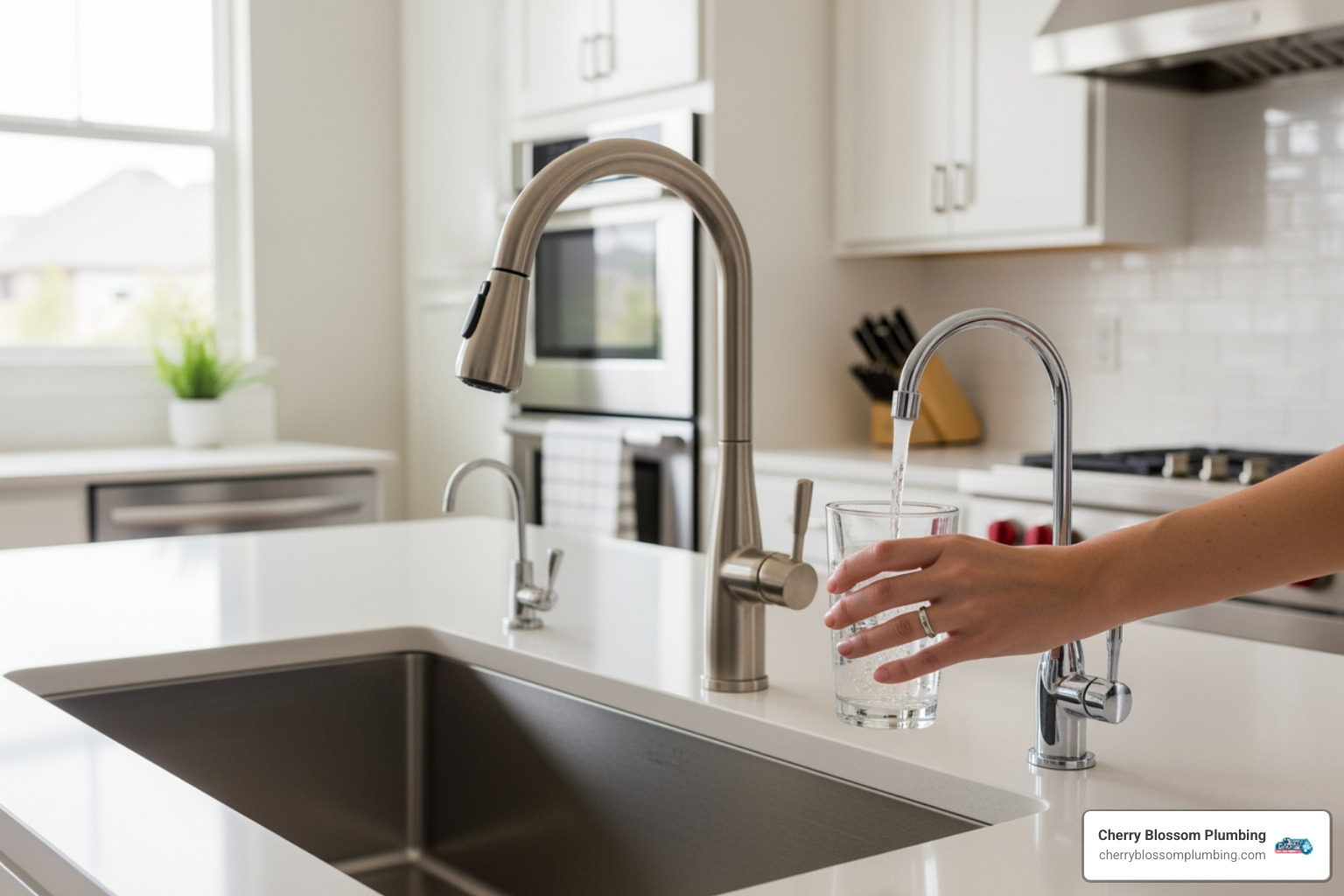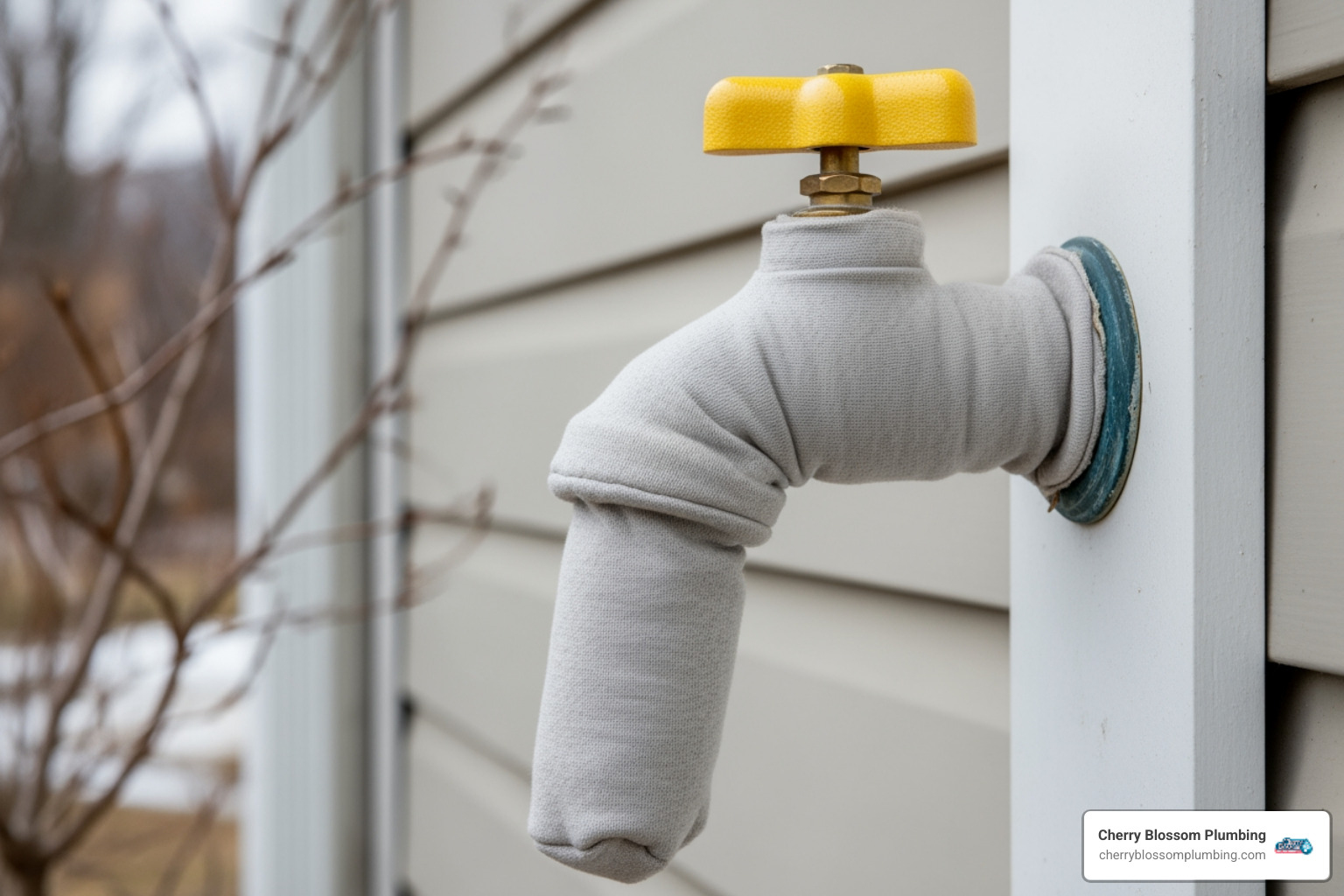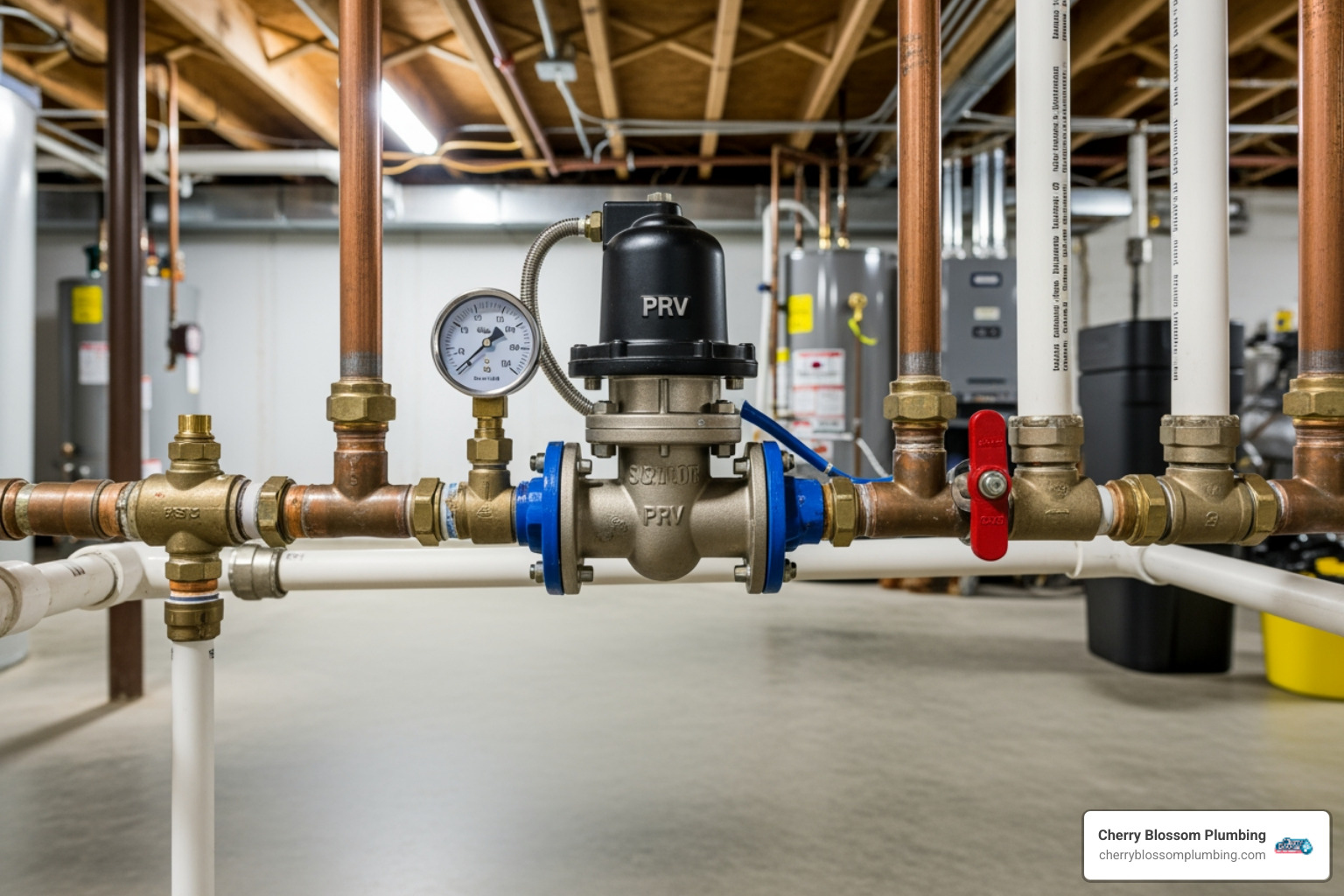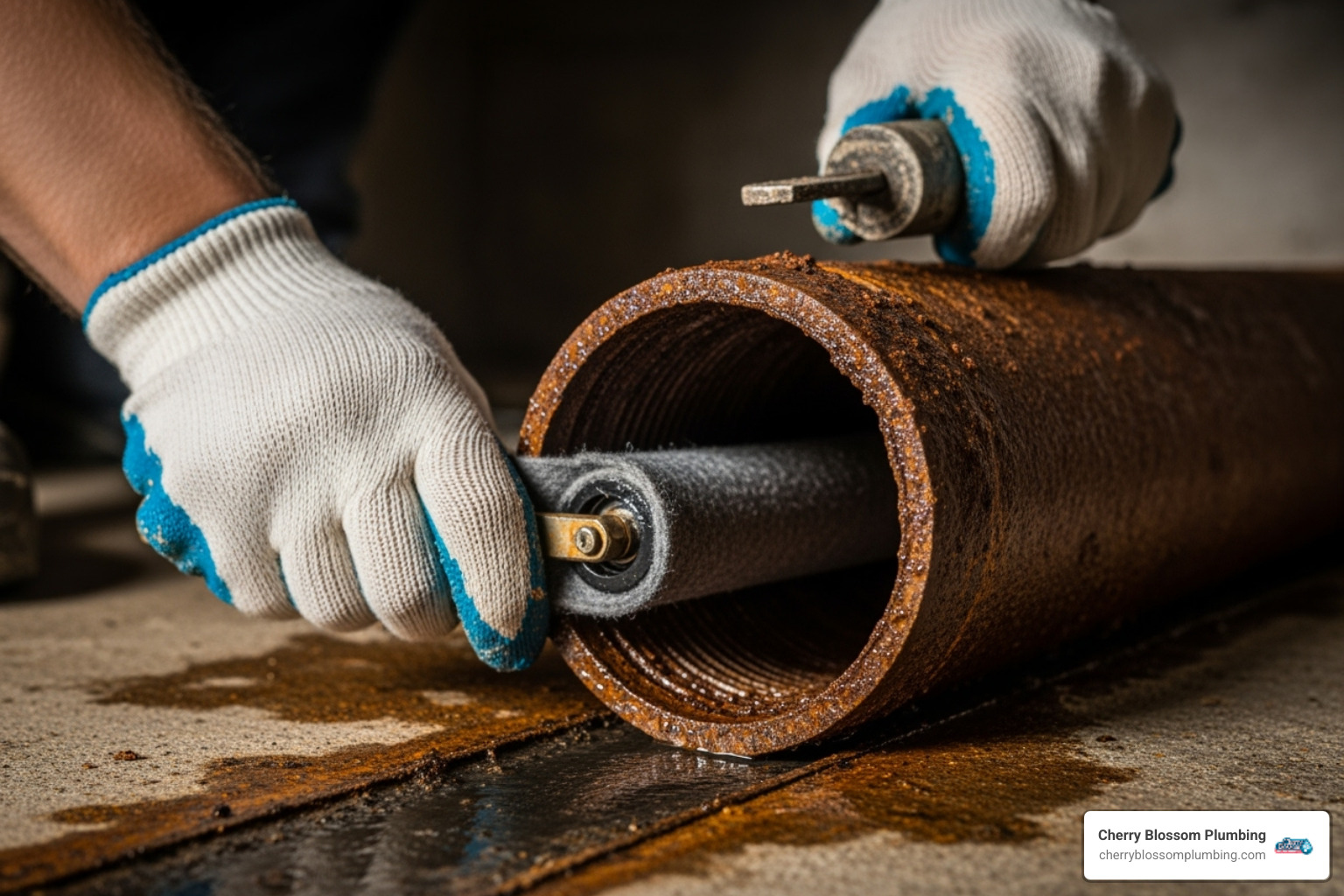
Why Cast Iron Pipe Problems Can't Wait
Cast iron sewage pipe repair is one of the most critical home maintenance issues you'll face, especially if your home was built before the 1970s. Here are the most common repair options available:
- Pipe Lining (CIPP) - Creates a new pipe inside your existing cast iron pipe
- Sectional Point Repair - Patches specific damaged areas without full replacement
- Pipe Descaling - Removes rust and buildup to restore flow
- Pipe Bursting - Replaces the entire line by pulling new HDPE pipe through the old cast iron
- Traditional Excavation - Complete removal and replacement with modern materials like PVC
Most homes built before the 1970s still rely on cast iron sewer pipes. These pipes were the gold standard for decades because of their strength and durability. But here's what many homeowners don't realize: cast iron pipes typically last 50 to 100 years, which means if your home is over 50 years old, you're likely sitting on a ticking time bomb.
Cast iron doesn't fail overnight. It corrodes from the inside out, developing rust, scaling, and eventually cracks or complete collapse. The rough interior surface catches debris, leading to recurring blockages. Tree roots find their way into weakened joints, causing even more damage.
The good news? Modern repair techniques can often solve these problems without destroying your landscaping or breaking the bank. From trenchless pipe lining that creates a new pipe inside your old one, to pipe bursting that replaces the entire line with minimal excavation, today's solutions are far less invasive than the dig-up-your-whole-yard methods of the past.
I'm Amanda Casteel, and my experience transitioning from managing complex Department of Justice IT projects to co-founding Cherry Blossom Plumbing has taught me that cast iron sewage pipe repair requires the same systematic approach I used in government work - proper diagnosis, clear processes, and reliable execution. My background in process improvement and team leadership helps ensure our technicians deliver consistent, high-quality solutions for Northern Virginia homeowners facing these underground challenges.
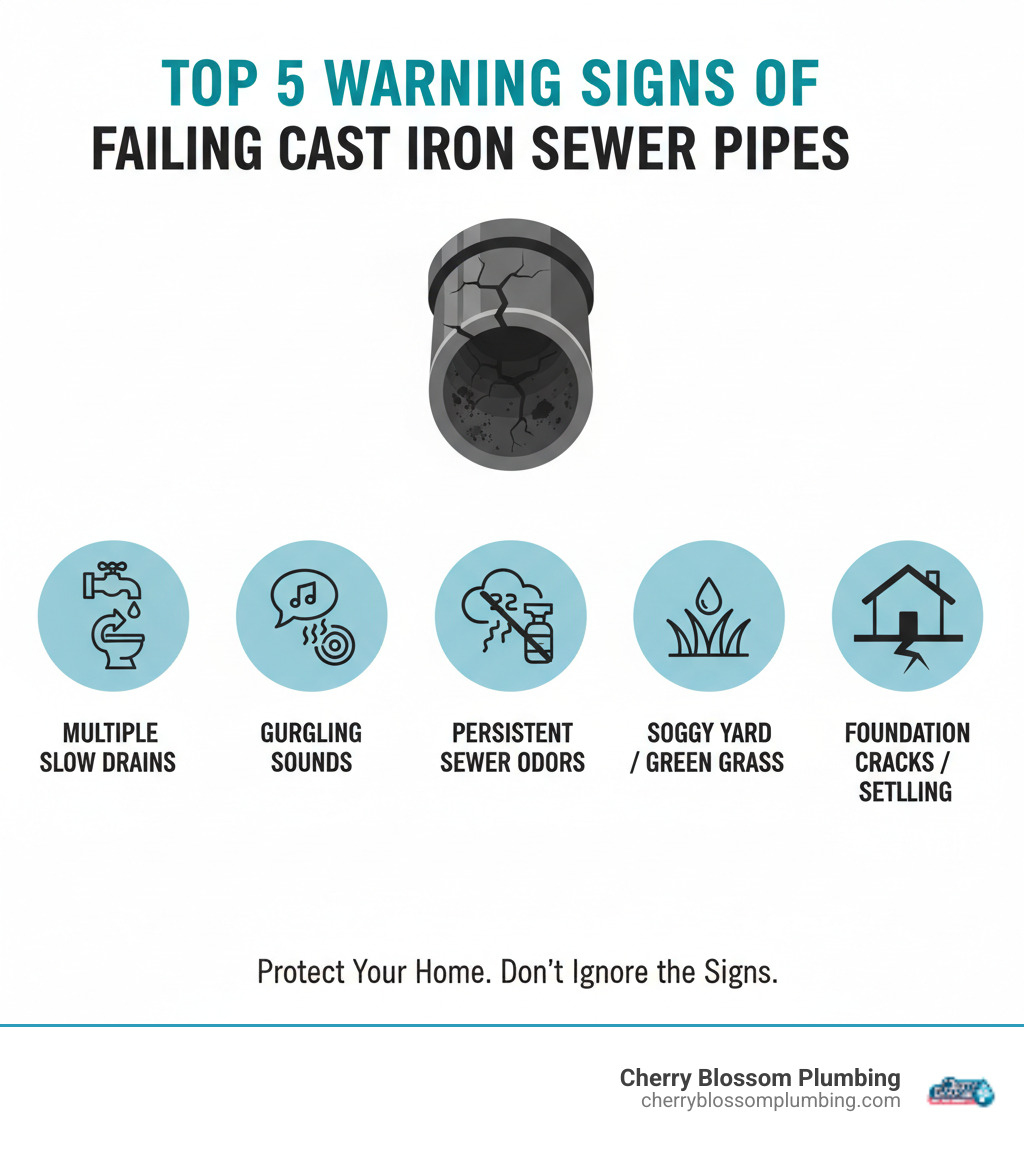
Understanding Your Cast Iron Pipes: Lifespan and Common Failures
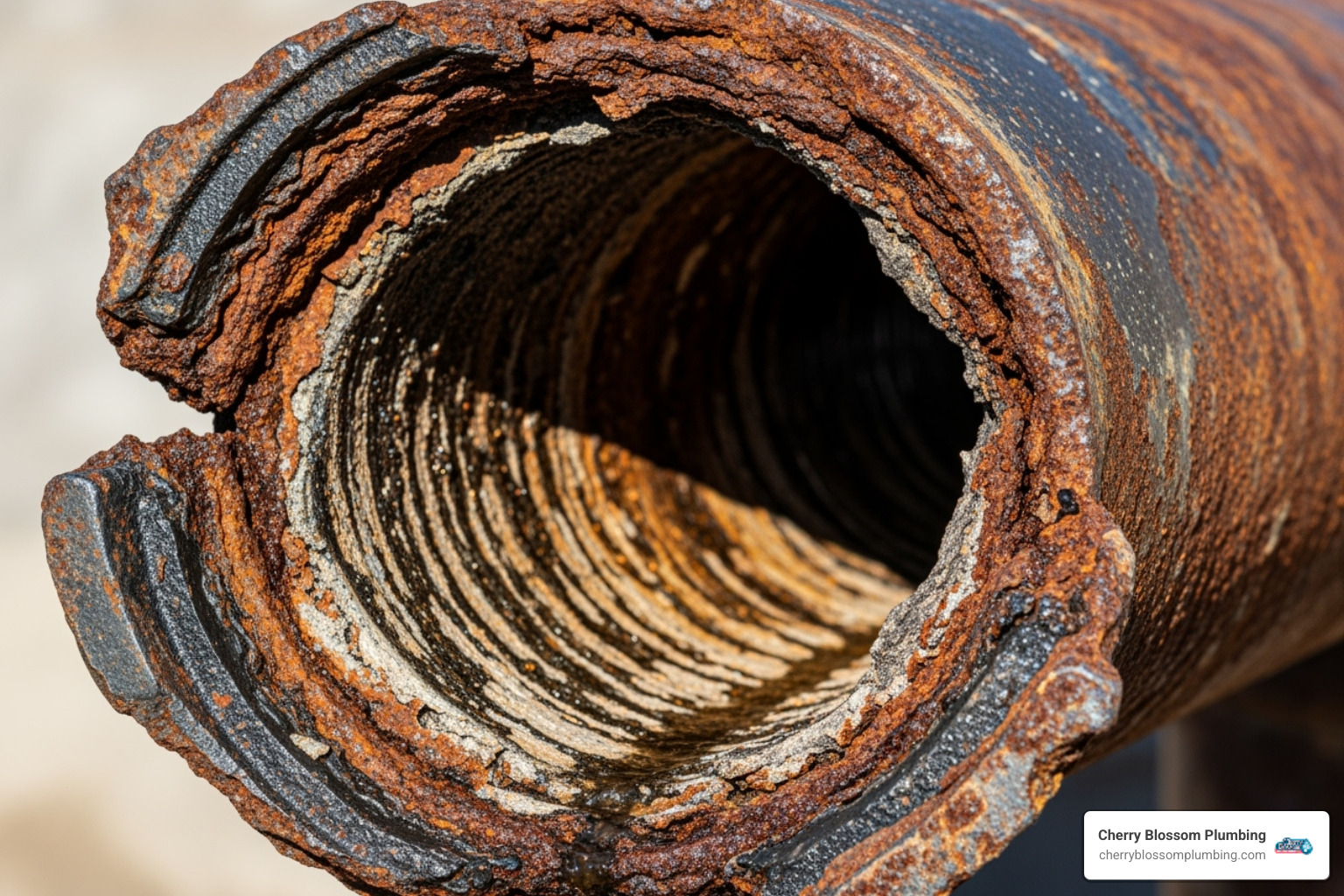
Walk into any older home in Arlington or Falls Church, and chances are you're standing above a network of cast iron pipes that have been faithfully doing their job for decades. These underground workhorses were the backbone of American plumbing from the early 1800s right up until the 1970s, and for good reason.
Cast iron was the superhero of plumbing materials back in the day. It was strong, fire-resistant, and built to last. It could handle the weight of soil and traffic, and homeowners appreciated that it seemed virtually indestructible. According to the Cast Iron Soil Pipe Institute, these pipes were the industry standard for good reason - their durability was best by other materials available at the time.
But cast iron pipes are like a reliable old car that suddenly starts showing its age. Most cast iron pipes last between 50 to 100 years, which means if your home was built in the 1960s or earlier, you're likely approaching (or past) the point where problems start appearing.
The lifespan of your cast iron pipes isn't just about age. Several factors determine if they'll last a century or fail after 40 years. Soil conditions play a huge role—acidic soil can eat away at the exterior of pipes much faster than neutral soil. Water chemistry matters too, especially what goes down your drains daily.
The way your pipes were originally installed makes a difference as well. Pipes that weren't sloped correctly or had poor welding at the seams tend to fail sooner. Even the best materials won't perform if the groundwork isn't right.
Corrosion is the silent killer of cast iron pipes, and it almost always starts from the inside out. As iron meets water and oxygen day after day, rust begins to form. This creates a rough, bumpy interior surface that's perfect for catching grease, hair, soap scum, and other debris.
This buildup, called scaling, gradually narrows the pipe's diameter. What started as a 4-inch pipe might effectively become a 2-inch pipe over time. That's why older homes often experience frequent backups even when there's no obvious blockage—the pipe is literally choking itself.
Channeling is another sneaky problem that develops over decades. The bottom of horizontal pipes slowly wears away, creating a groove or channel where wastewater flows. Eventually, this weakens the entire pipe structure, setting the stage for more serious failures.
As the pipe walls thin from corrosion, pinhole leaks start appearing, especially in above-ground sections. Underground pipes develop cracks that invite tree roots to come exploring. Once roots find their way in through these weak spots, they expand and create even bigger problems.
The final stage of cast iron deterioration involves bellies and collapsed sections. Bellies occur when weakened pipes sag under pressure, creating low spots where water and waste collect. Complete collapse happens when the pipe simply can't support itself anymore, leading to major blockages and sewage backups.
Understanding these failure patterns is crucial for effective cast iron sewage pipe repair. The good news is that modern repair techniques can address many of these problems without turning your yard into an archaeological dig site. But first, you need to recognize the warning signs that your cast iron pipes are crying for help.
Red Flags: Recognizing the Signs of a Failing Sewer Pipe
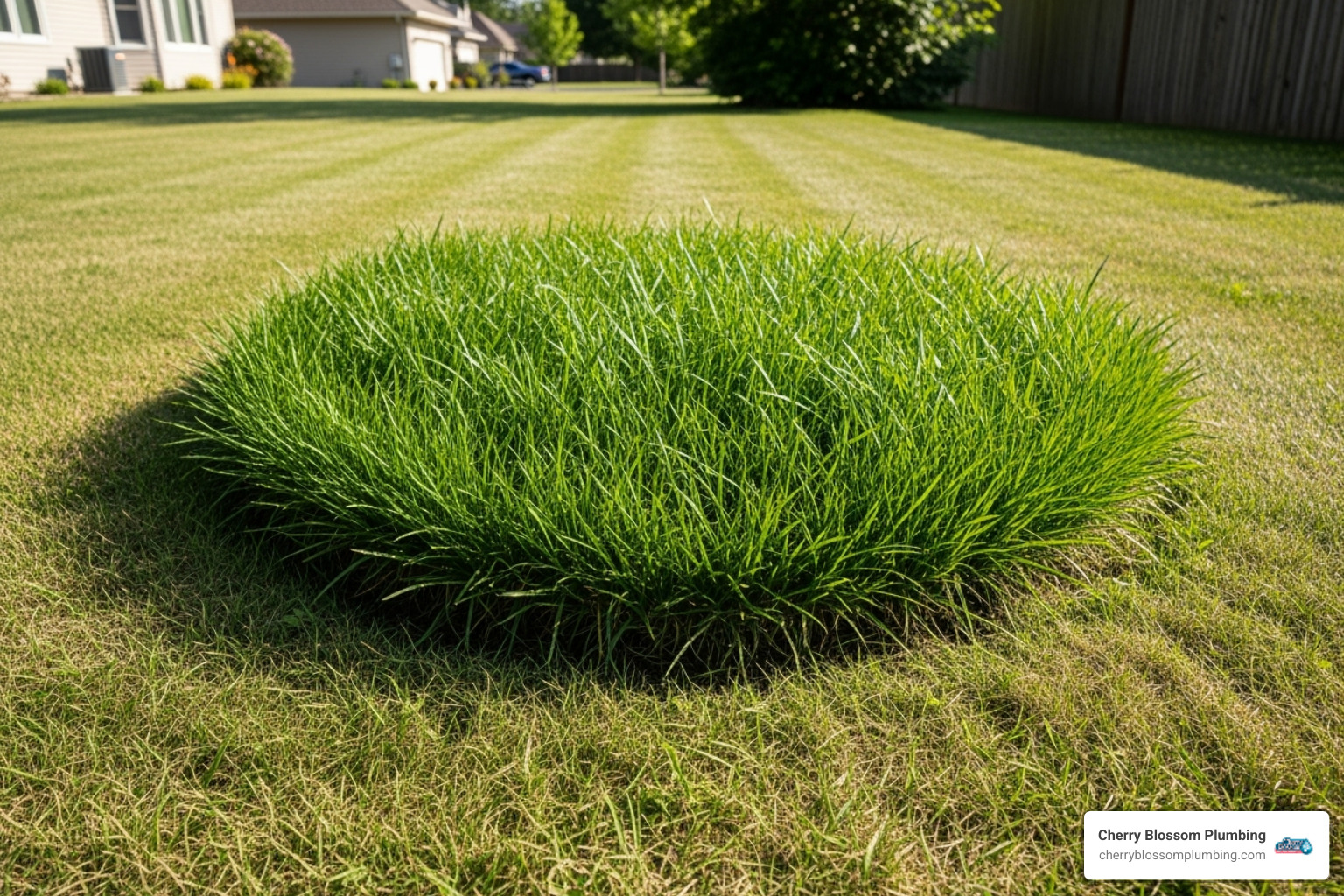
Your home's sewer system works quietly underground—until it doesn't. When cast iron pipes start failing, they often send subtle warning signals long before a full-blown emergency. Learning to recognize these red flags can save you from a sewage nightmare and thousands in damage.
The first sign many homeowners notice is multiple slow drains throughout the house. When your kitchen sink, bathroom drains, and shower all start draining sluggishly at the same time, it usually means there's a serious blockage or collapse in your main sewer line.
You might also hear your plumbing system making strange gurgling noises after you flush the toilet or drain the tub. These sounds happen when air gets trapped in the system, often because a damaged pipe is disrupting normal water flow.
Persistent sewer odors inside your home are another major red flag. If you're smelling something foul near drains or in your basement, sewer gases are likely escaping through cracks in your cast iron pipes. This isn't just unpleasant—it can be a health hazard too.
Your home might also show signs of hidden leaks through mold growth and damp spots in unexpected places. When cast iron pipes leak behind walls or under floors, that moisture has to go somewhere. You might notice musty smells, discolored walls, or actual mold patches where pipes are failing.
Your yard can also tell you a lot about your underground sewer system. An unusually lush, green patch of grass in your lawn might look beautiful, but it could be getting extra "fertilizer" from a leaking sewer line. Soggy areas that stay wet even during dry weather are another telltale sign.
Sometimes you'll notice dips or valleys forming in your yard where soil has washed away due to a leak. This settling can even affect your home's foundation, potentially causing foundation cracks as saturated soil expands and contracts.
Don't ignore an unexpected pest problem either. Rodents and insects are drawn to the moisture and waste from damaged pipes and can enter your home through cracks in failed cast iron lines. If you're suddenly dealing with more unwelcome visitors, your sewer pipes might be the cause.
Early detection is absolutely crucial when it comes to cast iron sewage pipe repair. The longer you wait, the more extensive and expensive the damage becomes. What starts as a small crack can quickly turn into a collapsed section that requires major excavation.
When you notice any of these warning signs, it's time for a professional diagnosis. We use advanced Sewer Camera Inspections to get a clear picture of what's happening inside your pipes. This technology lets us pinpoint problems and determine the best repair approach without guesswork.
When should you call a professional? If you've tried basic DIY solutions and problems persist, or if you're seeing multiple warning signs at once, don't wait. Our licensed plumbers have seen it all when it comes to cast iron pipe failures and can quickly determine the work needed to protect your home and family.
Your Guide to Professional Cast Iron Sewage Pipe Repair and Replacement
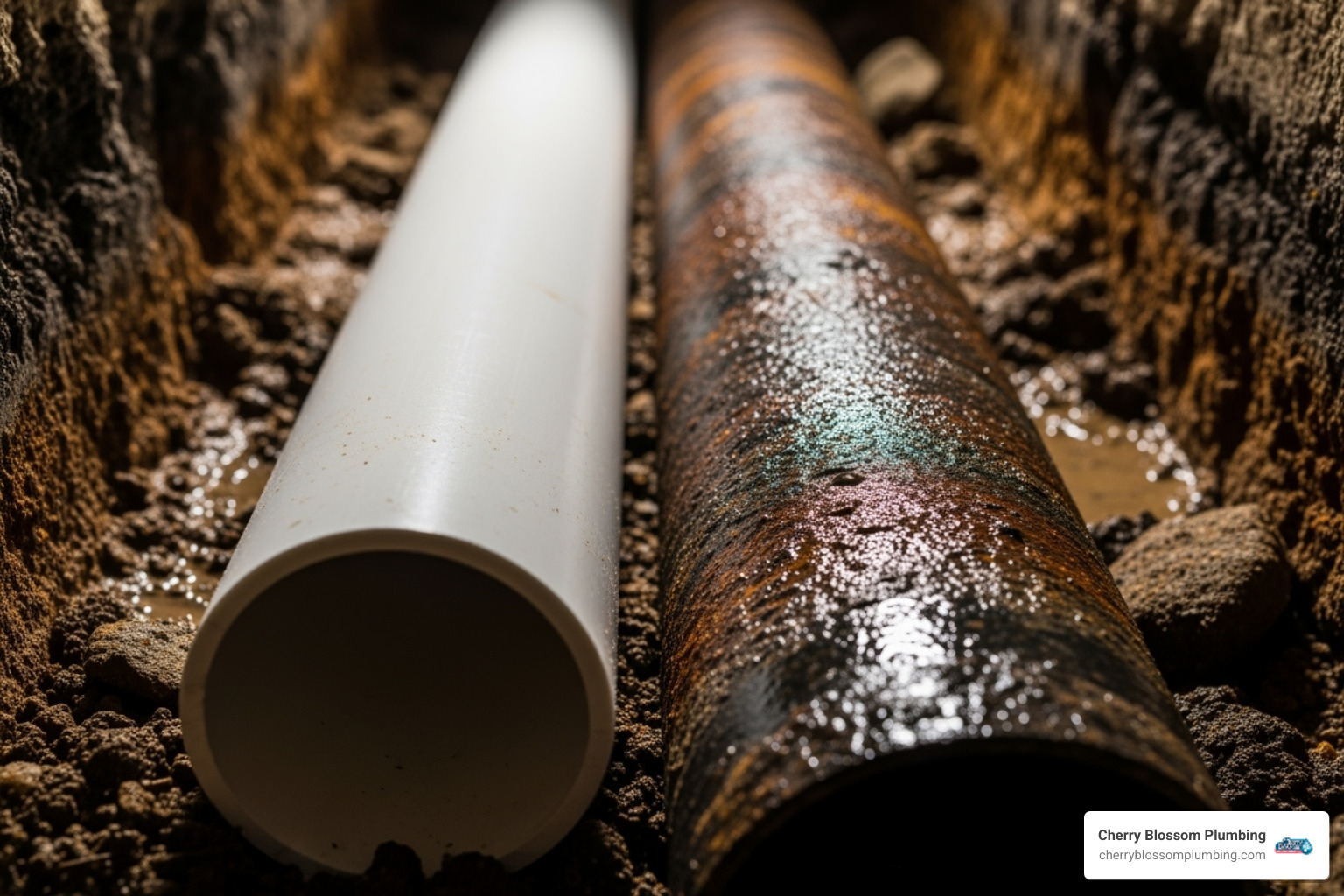
When your cast iron sewer pipes age, you face a key decision: repair or replace? It's a complex question that's best answered with professional guidance.
Every cast iron sewage pipe repair situation is unique. What works for one home may not be right for another. That's why we always start with a thorough professional diagnosis—making the wrong call can be a costly mistake.
The decision comes down to structural integrity. If pipes are generally sound, we can often repair them. If they are fundamentally failing, replacement is the only long-term solution.
Here's how we approach the most common methods for addressing cast iron pipe problems:
| Method | Type | Invasiveness | Application | When Used |
|---|---|---|---|---|
| Pipe Descaling | Repair | Minimal | Internal cleaning of rust/scale | Minor blockages, rough interior, preventative |
| Trenchless Lining | Repair | Minimal | Creates new pipe inside existing | Structurally sound pipes with internal corrosion/cracks |
| Sectional Patching | Repair | Minimal | Localized damage repair | Small cracks, pinholes, specific weak spots |
| Pipe Bursting | Replacement | Moderate (2 access points) | Pulls new pipe through old, destroying old one | Severely damaged/collapsed pipes, full replacement desired |
| Traditional Excavation | Replacement | High | Digs up and replaces entire pipe section | Severely damaged/collapsed, back-pitched pipes, total replacement |
For more detailed information about these approaches, you can explore our insights on Sewer Line Repair Explained and Sewer Repair Techniques for Optimal Functionality.
Modern Repair Methods for Cast Iron Sewage Pipe Repair
The good news about modern cast iron sewage pipe repair is that we can often solve your problems without turning your yard into an archaeological dig site. These repair methods have revolutionized how we approach aging cast iron systems.
Pipe descaling is like giving your pipes a deep cleaning. Over the years, rust and mineral buildup create a rough, narrowed interior that catches debris. Using specialized equipment, we can strip away these deposits and restore your pipes to nearly their original diameter, dramatically improving flow.
Trenchless pipe lining is an impressive process where we build a brand-new pipe inside your old one. This method, called CIPP (Cured-in-Place Pipe), involves inserting a flexible, epoxy-saturated liner into your existing pipe, inflating it, and letting it cure. The result is a seamless, jointless pipe that can last another 50 years or more, usually requiring only a single access point.
For smaller, localized problems, sectional point repair can be a perfect solution. Think of it as a high-tech patch for your pipes. When you have a specific crack or leak, we can apply specialized wrapping or epoxy compounds directly to that area. It's quick, effective, and less expensive than replacing an entire pipe section.
These modern repair techniques are less invasive, meaning your landscaping and driveway stay intact and you avoid a lengthy construction project. Most importantly, they work incredibly well when applied to the right situations.
When Replacement is the Only Solution
Sometimes, replacement is the only honest and cost-effective recommendation. Repairing severely damaged pipes is not a good investment if the core structure has failed.
Collapsed pipes are the most obvious example. When a section has caved in, no amount of lining or patching will restore its function. Similarly, if we find severe corrosion throughout the system, with multiple large holes and extensive thinning, the pipe has reached the end of its useful life.
Back-pitching is another deal-breaker. This happens when pipes lack the proper slope due to poor installation or ground settling. Water needs gravity to flow, and when sections slope backward, you'll have chronic backup problems that repairs can't fix.
Extensive tree root intrusion can also push a system beyond repair. Roots don't just grow into pipes—they can completely destroy them, creating multiple failure points that make repair impractical.
When replacement is necessary, we have two main approaches. Traditional excavation involves digging up the old pipe and installing a new system. While disruptive, it's sometimes the only way to address severe damage or correct issues like back-pitching.
Pipe bursting offers a much less invasive alternative. We dig small access pits, then use a specialized bursting head to destroy the old pipe while pulling a new HDPE pipe into place. It's a highly effective replacement method with minimal disruption to your property.
The benefits of replacing cast iron with modern materials like PVC or HDPE are substantial. These materials resist corrosion, provide smooth interiors for better flow, and can last 75-100 years with proper installation, essentially future-proofing your home's sewer system.
We take pride in How We Handle Sewer Line Repair and addressing all Sewer Line Repair Issues and Solutions with the expertise and care your home deserves.
Frequently Asked Questions about Cast Iron Pipes
When homeowners in Northern Virginia find they have cast iron pipe issues, they often feel overwhelmed. Over the years, we've helped countless families with these concerns, and certain questions come up again and again. Here are the most common ones.
How long do cast iron sewer pipes typically last?
This is the first question most homeowners ask. The honest answer is that cast iron pipes typically last between 50 to 100 years, but that range exists for good reasons.
A pipe's actual lifespan depends on several key factors we see affecting homes throughout Arlington and Falls Church.
Environmental factors play a huge role. Acidic soil can accelerate external corrosion, while shifting clay soil can stress pipe joints. Pipes in sandy, well-draining soil often last much longer than those in wet, acidic conditions.
Water quality and usage patterns also make a significant difference. Hard water can cause more internal scaling, while harsh chemical drain cleaners can eat away at the pipe walls from the inside. Even consistently running very hot water can accelerate deterioration.
Installation quality from decades ago continues to affect your pipes today. Pipes installed with proper slopes and correctly sealed joints tend to outlast those that were rushed or improperly fitted.
Here's what I always tell homeowners: the condition of your pipes matters far more than their age alone. I've seen 80-year-old pipes in great shape and 45-year-old pipes that needed immediate replacement. That's why we recommend professional Sewer Camera Inspections for Healthy Plumbing to get a clear picture of what's happening inside your system.
Can tree roots really break strong cast iron pipes?
Yes, tree roots can absolutely destroy even the strongest cast iron pipes. It's one of the most common problems we encounter during cast iron sewage pipe repair calls.
The process is relentless. Tree roots are constantly seeking moisture and nutrients, and the nutrient-rich wastewater in your pipes is exactly what they need to thrive.
Here's how the destruction unfolds: roots don't usually break perfect pipes initially. Instead, they're opportunistic, finding their way into tiny gaps at pipe joints, hairline cracks, or small openings where corrosion has already begun.
Once roots find these vulnerable entry points, they begin the real damage. The roots expand as they grow, exerting tremendous pressure on the pipe walls. What started as a small crack becomes a large fracture. The rough interior of aging cast iron gives roots plenty of texture to grip and spread.
We've pulled roots as thick as an arm out of cast iron pipes, completely filling the line. In extreme cases, roots can cause a complete pipe collapse.
Prevention strategies include being mindful of where you plant trees, installing root barriers, and scheduling regular inspections to catch intrusions before they become major disasters. The key is catching root problems early.
What's the difference between pipe lining and pipe bursting?
These two terms are often used in discussions about modern cast iron sewage pipe repair. Both are trenchless methods that avoid tearing up your yard, but they serve very different purposes.
Pipe lining is a repair and reinforcement technique. We insert a flexible, epoxy-saturated liner into your current pipe. Once in place, we inflate the liner and allow it to cure, creating a seamless new pipe within the shell of your old one.
This method works beautifully for pipes that are still structurally sound but have internal issues like corrosion, small cracks, or pinhole leaks. The original pipe stays in place and provides support, while the new liner handles the wastewater flow.
Pipe bursting, on the other hand, is a complete replacement method. We pull a new high-density polyethylene pipe through the path of your old cast iron line. A specialized bursting head breaks apart the old pipe, pushing the fragments into the surrounding soil.
This approach is necessary when pipes are severely damaged, collapsed, or beyond what lining can fix. If your pipe has significant structural damage, pipe lining won't solve the underlying problem. Pipe bursting gives you a completely new, durable pipe designed to last for decades.
The choice between these methods comes down to an honest assessment of your pipe's condition. Both avoid the disruption of traditional excavation, but understanding which approach addresses your specific Sewer Line Repair Issues and Solutions ensures you get a long-lasting fix.
Conclusion: Protecting Your Home with Proactive Sewer Line Care
Taking care of your cast iron sewer pipes isn't just about fixing problems when they happen—it's about protecting your biggest investment: your home. Throughout this guide, we've walked through the warning signs of failing pipes, from those telltale gurgling sounds to mysteriously lush patches in your yard. We've explored modern repair solutions that can save your landscaping and your wallet, and we've covered when replacement becomes the smartest long-term choice.
The truth is, cast iron sewage pipe repair doesn't have to be a homeowner's nightmare. When you recognize the signs early and take prompt action, you're setting yourself up for success. Think about it this way: a small investment in preventive care today can save you from the stress and expense of emergency repairs down the road.
The long-term benefits of proactive sewer line care extend far beyond just working plumbing. You'll prevent costly property damage from sewage backups and foundation issues. Your family's health stays protected from harmful sewer gases and potential contamination. Plus, a well-maintained sewer system actually helps maintain your property value—because nobody wants to buy a home with plumbing problems lurking underground.
Here are some simple steps that make a real difference in extending your pipes' lifespan. Proper waste disposal means being mindful of what goes down your drains—those "flushable" wipes really aren't as flushable as advertised, and neither are paper towels or feminine hygiene products. Avoiding harsh chemicals is equally important; while that powerful drain cleaner might seem like a quick fix, it can actually accelerate corrosion in aging cast iron pipes. Instead, try enzyme-based cleaners or call a professional for stubborn clogs.
Most importantly, schedule regular inspections with sewer camera technology. It's like getting a check-up for your plumbing system. We can spot small issues like early root intrusion or minor corrosion before they turn into major headaches.
At Cherry Blossom Plumbing, we understand that dealing with sewer problems can feel overwhelming. That's why our licensed professionals focus on providing expert diagnosis and reliable solutions with clear explanations every step of the way. We serve homeowners throughout Arlington, Falls Church, Alexandria, Fairfax, McLean, and surrounding Northern Virginia communities, always with our "WOW factor" guarantee.
Don't wait until you're dealing with sewage backing up into your basement or soggy spots destroying your landscaping. Let us help you stay ahead of potential problems with a professional inspection.
Contact us for professional plumbing services today to schedule your sewer camera inspection or discuss your cast iron sewage pipe repair options. Your future self will thank you.
Customer Testimonials
Cherry Blossom Plumbing has consistently provided top-notch service, ensuring every issue is resolved efficiently and professionally.





